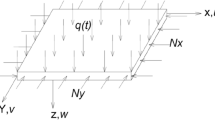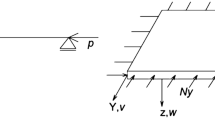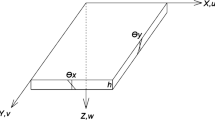Abstract
In this paper, a dynamic stability analysis of moderately thick viscoelastic plates is performed employing the Boltzmann integral law with constant bulk modulus. The remarkable and new point of the proposed method is that the frequency of a Mindlin viscoelastic plate subjected to simultaneous constant and harmonic in-plane compressive loads is explicitly predictable based on free vibration analysis of an elastic plate. Moreover, the damped part of frequency is easily calculated. Also, the critical excitation for which the system becomes unstable is determined. This method is completely new and significantly reduces the computational cost. The obtained results are compared with other existing results to show the efficiency and accuracy of the proposed method. This method is used to investigate the effects of viscoelastic properties and in-plane compressions on the steady-state responses of Mindlin viscoelastic plates under time-dependent compressive loads.









Similar content being viewed by others
References
Dost, S., Glockner, P.G.: On the dynamic stability of viscoelastic perfect column. Int. J. Solids Struct. 18(7), 587–596 (1982)
Szyszkowski, W., Glockner, P.G.: The stability of viscoelastic perfect column: a dynamic approach. Int. J. Solids Struct. 21(6), 545–559 (1985)
Li, G., Zhu, Z., Cheng, C.: Dynamic stability of viscoelastic column with fractional derivative constitutive relation. Appl. Math. Mech. 22(3), 294–310 (2001)
Leung, A.Y.T., Yang, H.X., Chen, J.Y.: Parametric bifurcation of a viscoelastic column subject to axial harmonic force and time delayed control. Comput. Struct. 136, 47–55 (2014)
Aboudi, J., Cederbaum, G.: Dynamic stability of viscoelastic plates by Lyapunov exponents. J. Sound Vib. 139(3), 459–467 (1990)
Teifouet, A.R.M.: Nonlinear vibration of 2D viscoelastic plate subjected to tangential follower force. Eng. Mech. 20(1), 59–74 (2013)
Amabili, M.: Nonlinear vibration of viscoelastic rectangular plates. J. Sound Vib. 362, 142–156 (2016)
Balasubramanian, P., Ferrari, G., Amabili, M.: Identification of the viscoelastic response and nonlinear damping of a rubber plate in nonlinear vibration regime. Mech. Syst. Signal Process. 111, 376–398 (2018)
Amabili, M.: Nonlinear damping in nonlinear vibrations of rectangular plates: derivation from viscoelasticity and experimental validation. J. Mech. Phys. Solids 118, 275–292 (2018)
Zhou, Y.F., Wang, Z.M.: Dynamic instability of axially moving viscoelastic plate. Eur. J. Mech. A. Solids. 73, 1–10 (2019)
Amabili, M., Balasubramanian, P., Ferrari, G.: Nonlinear vibrations and damping of fractional viscoelastic rectangular plates. Nonlinear Dyn. 103, 3581–3609 (2021)
Singha, M.K., Daripa, R.: Nonlinear vibration and dynamic stability analysis of composite plates. J. Sound Vib. 328, 541–554 (2009)
Zamani, H.A., Aghdam, M.M., Sadighi, M.: Free vibration analysis of thick viscoelastic composite plates on visco-Pasternak foundation using higher-order theory. Compos. Struct. 182, 25–35 (2017)
Jafari, N., Azhari, M., Boroomand, B.: Geometrically nonlinear analysis of time-dependent composite plates using time function optimization. Int. J. Non Linear Mech. 116, 219–229 (2019)
Arshid, E., Amir, S., Loghman, A.: Static and dynamic analyses of FG-GNPs reinforced porous nanocomposite annular micro-plates based on MSGT. Int. J. Mech. Sci. 180, 105656 (2020)
Amir, S., Arshid, E., Khoddami Maraghi, Z.: Free vibration analysis of magneto-rheological smart annular three-layered plates subjected to magnetic field in viscoelastic medium. Smart Struct. Syst. 25, 581–592 (2020)
Amir, S., Arshid, E., Rasti-Alhosseini, S.M.A., Loghman, A.: Quasi-3D tangential shear deformation theory for size-dependent free vibration analysis of three-layered FG porous micro rectangular plate integrated by nano-composite faces in hygrothermal environment. J. Therm. Stresses 43(2), 133–156 (2020)
Jafari, N., Azhari, M.: Free vibration analysis of viscoelastic plates with simultaneous calculation of natural frequency and viscous damping. Math. Comput. Simul. 185, 646–659 (2021)
Khorasani, M., Soleimani-Javid, Z., Arshid, E., Amir, S., Civalek, Ö.: Vibration analysis of graphene nanoplatelets’ reinforced composite plates integrated by piezo-electromagnetic patches on the piezo-electromagnetic media. In: Waves in Random and Complex Media. https://doi.org/10.1080/17455030.2021.1956017
Ilyasov, M.H., Akoz, A.Y.: The vibration and dynamic stability of viscoelastic plates. Int. J. Eng. Sci. 38, 695–714 (2000)
Eshmatov, BKh.: Dynamic stability of viscoelastic plates under increasing compressing loads. J. Appl. Mech. Tech. Phys. 47(2), 289–297 (2006)
Eshmatov, BKh.: Nonlinear vibration and dynamic stability of viscoelastic orthotropic rectangular plates. J. Sound Vib. 300, 709–726 (2007)
Sofiyev, A.H., Zerin, Z., Kuruoglu, N.: Dynamic behavior of FGM viscoelastic plates resting on elastic foundations. Acta Mech. 231, 1–17 (2020)
Zhang, N.H., Cheng, C.J.: Nonlinear mathematical model of viscoelastic thin plates with its applications. Comput. Methods Appl. Mech. Eng. 16(5), 307–319 (1998)
Jafari, N., Azhari, M.: Stability analysis of arbitrarily shaped moderately thick viscoelastic plates using Laplace–Carson transformation and a simple hp cloud method. Mech. Time Depend. Mater. 21(3), 365–381 (2017)
Touati, D., Cederbaum, G.: Dynamic stability of nonlinear viscoelastic plates. Int. J. Solids Struct. 31(17), 2367–2376 (1994)
Jafari, N., Azhari, M.: Geometrically Nonlinear Analysis of Thick Orthotropic Plates with Various Geometries Using Simple Hp-Cloud Method. Eng. Comput. 33(5), 1451–1471 (2016)
Civalek, Ö.: Three-dimensional vibration, buckling and bending analyses of thick rectangular plates based on discrete singular convolution method. Int. J. Mech. Sci. 49, 752–765 (2007)
Jafari, N., Azhari, M., Heidarpour, A.: Local buckling of rectangular viscoelastic composite plates using finite strip method. Mech. Adv. Mater. Struct. 21, 263–272 (2014)
Amabili, M.: Nonlinear Mechanics of Shells and Plates: Composite, Soft and Biological Materials. Cambridge University Press, Cambridge (2018)
Acknowledgements
The authors would like to thank Professor Bijan Boroomand, for his contributions in studying the manuscript, and his valuable comments and useful suggestions.
Author information
Authors and Affiliations
Corresponding author
Ethics declarations
Conflict of interest
The authors declare that they have no conflict of interest.
Additional information
Publisher's Note
Springer Nature remains neutral with regard to jurisdictional claims in published maps and institutional affiliations.
Appendix: Dynamic stability analysis of a simply supported viscoelastic column
Appendix: Dynamic stability analysis of a simply supported viscoelastic column
The equation of a viscoelastic column subjected to a time-dependent compressive load \(p\left( t \right)\), as illustrated in Fig. 10, is defined as [2]:
in which \(x\) is the longitudinal axis, \(w\) is the transverse displacement, and \(m\) denotes the mass per unit length.
The bending moment \(M\) can be expressed as:
where \(y\) is the transverse axis.
The constitutive equation of a linear viscoelastic material based on the Boltzmann integral can be given as [24]:
where \(E\left( t \right)\) is the relaxation function. It is noted that in case of steady harmonic vibrations employing Eq. (82) is not necessary, and the problem reduces to the study of the storage and loss modulus [30]. But, since the goal of this paper is to study the dynamic stability of columns subjected to axial compression, using Eq. (83) is necessary.
For a Bernoulli beam, the relation between the strain \(\varepsilon\) and the deflection \(w\) can be written as [2]:
Considering simply supported boundary conditions and by supposing that all points of the column move in phase, the deflection may be represented by [1, 4]:
The relaxation function can be defined as follows:
where \(E_{0}\) is the elasticity modulus at time zero.
Substituting Eqs. (82–85) into Eq. (80), Eq. (86) is obtained:
in which \(I\) is the column moment of inertia.
The time-dependent compressive load, \(p\left( t \right)\), may be given as:
in which \(\alpha_{1}\) and \(\beta_{1}\) are constant, and \(\varphi\) is the excitation frequency. Replacing Eq. (87) in Eq. (85), Eq. (88) is obtained:
where the fundamental natural frequency at time zero is defined as follows:
For a viscoelastic column, the time function can be defined as:
So, one can write Eq. (91) as follows:
Replacing Eq. (91) in Eq. (88), Eq. (92) is obtained:
If Laplace transform is taken from Eq. (92), Eq. (93) is obtained:
in which \(\eta^{*}\), \(F^{*}\), \(\ddot{F}^{*},\) and \(\left( {\cos \varphi tF\left( t \right)} \right)^{*}\) are the Laplace transformations of \(\eta \left( t \right)\), \(F\left( t \right)\), \(\ddot{F}\left( t \right)\), and \(\cos \varphi tF\left( t \right)\), respectively.
According to Laplace transform properties, the second term of Eq. (93) can be calculated as:
On the other hand, the convolution integral of Eq. (94) can be calculated as:
Using Eqs. (90) and (95), Eq. (93) can be simplified as:
Alternatively:
If Eq. (92) is solved in the time domain too, Eq. (98) is derived:
Comparing Eq. (97) and Eq. (98), the Laplace parameter in Eq. (97) can be replaced by \(i\left( {\omega_{0} + \varphi } \right){ },\) that is, \(s = i\left( {\omega_{0} + \varphi } \right)\).
Replacing \(s = i\left( {\omega_{0} + \varphi } \right)\) and ignoring \(\eta^{*} = \frac{{c_{1} }}{{i\left( {\omega_{0} + \varphi } \right)}} + \frac{{c_{2} }}{{i\left( {\omega_{0} + \varphi } \right) + \lambda }}\), Eq. (97) can be rewritten as follows:
Replacing \(s_{0} = i\omega_{0} - \alpha_{0}\) in Eq. (99) and separating the real and imaginary parts, Eqs. (100) and (101) are obtained:
Since \(\alpha_{0} \ll {\Omega },{ }\lambda \ll {\Omega }\), by ignoring \(\left( {\alpha_{0/} {\Omega }} \right)^{2}\), \(\left( {\lambda /{\Omega }} \right)^{2}\), and \(\left( {\lambda /{\Omega }} \right)\left( {\alpha_{0/} {\Omega }} \right)\), Eqs. (102–103) are derived:
Inserting \(\omega_{0}\) in Eq. (103), \(\alpha_{0}\) is obtained:
Alternatively:
If the free vibration is studied (\(\alpha_{1} = 0,\beta_{1} = 0\)), then \(\omega_{0} \approx {\Omega }\) and \(\alpha_{0} \approx \frac{{c_{2} \lambda }}{2}\), which is consistent with the results of Ref. [2].
Substituting Eqs. (102) and (103) into Eq. (84), Eq. (105) is derived
Considering Eq. (104), the viscoelastic column is always stable if the conditions below are satisfied:
Finally, one can solve Eq. (107) for calculating \(\beta_{{{\text{cr}}}}\) as follows:
Rights and permissions
About this article
Cite this article
Jafari, N., Azhari, M. Dynamic stability analysis of Mindlin viscoelastic plates subjected to constant and harmonic in-plane compressions based on free vibration analysis of elastic plates. Acta Mech 233, 2287–2307 (2022). https://doi.org/10.1007/s00707-022-03215-5
Received:
Revised:
Accepted:
Published:
Issue Date:
DOI: https://doi.org/10.1007/s00707-022-03215-5





